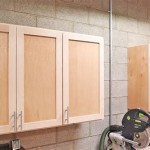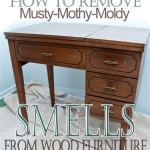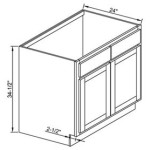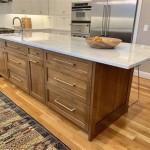How To Clean Golden Oak Kitchen Cabinets
Golden oak kitchen cabinets were a popular choice for many homeowners for decades. Their warm, honey-toned finish added a touch of classic charm to kitchens of all sizes. While the popularity of cabinet styles has evolved, many homes still feature these durable and character-rich cabinets. Knowing how to properly clean golden oak cabinets is essential for preserving their beauty and extending their lifespan. Improper cleaning techniques can damage the finish, leading to discoloration, peeling, or other unsightly problems. This article provides a comprehensive guide to cleaning golden oak kitchen cabinets effectively and safely.
The first step in cleaning golden oak cabinets is to understand the type of finish applied. Most golden oak cabinets feature a polyurethane or varnish finish, which provides a protective layer over the wood. This finish is relatively durable but can still be susceptible to damage from harsh chemicals, abrasive cleaners, and excessive moisture. Before embarking on a full cleaning regimen, it is crucial to determine the specific finish type. A simple test can be conducted in an inconspicuous area of the cabinet, such as the inside of a door or drawer. Apply a small amount of mild dish soap and water to the area and gently rub with a soft cloth. If the finish remains intact and does not become cloudy or sticky, it is likely a polyurethane or varnish finish. If the finish appears to dissolve or become damaged, it indicates a more delicate finish that requires specialized cleaning methods.
Gathering the Necessary Supplies
The key to successful cabinet cleaning lies in using the right supplies. Gathering these items beforehand ensures a smooth and efficient cleaning process. Here's a list of essential supplies:
- Mild Dish Soap: A gentle dish soap, free of harsh chemicals or abrasives, is ideal for cleaning most cabinet finishes.
- Warm Water: Warm water helps to dissolve grease and grime more effectively than cold water.
- Soft Cloths: Microfiber cloths are excellent for cleaning cabinets as they are soft, absorbent, and non-abrasive. Avoid using abrasive sponges or scouring pads, as they can scratch the finish.
- Spray Bottle: A spray bottle allows for easy application of the cleaning solution.
- Old Toothbrush: An old toothbrush is useful for cleaning hard-to-reach areas, such as corners and crevices.
- Baking Soda (Optional): Baking soda can be used as a mild abrasive for removing stubborn stains.
- White Vinegar (Optional): White vinegar is a natural degreaser and can be used to remove grease and grime. However, it should be diluted with water to avoid damaging the finish.
- Wood Polish (Optional): A good quality wood polish or cabinet cleaner can restore shine and protect the finish after cleaning.
- Clean, Dry Towel: A clean, dry towel is used to dry the cabinets after cleaning to prevent water spots.
Having these supplies readily available will streamline the cleaning process and minimize the risk of damage to the cabinets.
The Cleaning Process: A Step by Step Guide
The cleaning process should be approached systematically to ensure thoroughness and avoid damaging the cabinets. Here's a step-by-step guide to cleaning golden oak kitchen cabinets:
- Prepare the Cleaning Solution: In a spray bottle, mix a small amount of mild dish soap with warm water. The general guideline is to use about one teaspoon of dish soap per quart of water. Avoid using too much soap, as it can leave a residue on the cabinets.
- Test the Solution: Before applying the cleaning solution to the entire cabinet surface, test it in an inconspicuous area to ensure it does not damage the finish. Allow the solution to sit for a few minutes, then wipe it away with a clean cloth. Examine the area for any signs of discoloration, cloudiness, or damage.
- Apply the Cleaning Solution: Lightly spray the cleaning solution onto a small section of the cabinets. Avoid saturating the wood, as excessive moisture can damage the finish.
- Wipe the Cabinets: Using a soft cloth, gently wipe the cabinets in a circular motion to remove dirt, grease, and grime. Pay attention to areas that tend to accumulate more grime, such as around the stove and sink.
- Clean Hard-to-Reach Areas: Use an old toothbrush to clean hard-to-reach areas, such as corners, crevices, and around hardware. Dip the toothbrush in the cleaning solution and gently scrub the area.
- Rinse the Cabinets: After wiping the cabinets with the cleaning solution, rinse them with a clean, damp cloth. This will remove any soap residue.
- Dry the Cabinets: Immediately dry the cabinets with a clean, dry towel to prevent water spots.
- Polish the Cabinets (Optional): Once the cabinets are completely dry, apply a wood polish or cabinet cleaner to restore shine and protect the finish. Follow the manufacturer's instructions for application.
By following these steps carefully, you can effectively clean your golden oak cabinets without damaging the finish.
For particularly stubborn stains or grease buildup, more targeted cleaning methods may be necessary. Baking soda and white vinegar can be effective for tackling these challenges, but they should be used with caution and tested in an inconspicuous area first.
To use baking soda, create a paste by mixing baking soda with a small amount of water. Apply the paste to the stain or grease buildup and gently rub with a soft cloth. Rinse the area with a clean, damp cloth and dry thoroughly. Avoid using excessive pressure, as baking soda can be mildly abrasive.
To use white vinegar, dilute it with water in a 1:1 ratio. Spray the solution onto the grease buildup and let it sit for a few minutes. Wipe the area with a soft cloth and rinse with a clean, damp cloth. Dry thoroughly. Vinegar's acidity helps to break down grease, making it easier to remove.
Always remember to test any cleaning solution in a hidden area before applying it to the entire cabinet surface.
Maintaining Golden Oak Cabinets for Long-Term Beauty
Preventative measures can significantly reduce the frequency and intensity of cleaning required. Adopting a few simple habits can help maintain the beauty of your golden oak cabinets for years to come.
- Wipe Up Spills Immediately: Promptly wipe up any spills or splashes on the cabinets to prevent them from staining or damaging the finish.
- Use a Range Hood: Operate the range hood while cooking to vent steam, grease, and other airborne particles that can accumulate on the cabinets.
- Avoid Excessive Moisture: Prevent excessive moisture from coming into contact with the cabinets. This includes avoiding placing wet dishes or sponges directly on the cabinet surfaces.
- Dust Regularly: Dust the cabinets regularly with a soft cloth to remove dust and debris that can scratch the finish.
- Avoid Abrasive Cleaners: Never use abrasive cleaners, scouring pads, or steel wool on golden oak cabinets, as they can scratch the finish.
- Protect from Sunlight: Prolonged exposure to direct sunlight can fade and discolor the finish. Consider using window treatments to protect the cabinets from direct sunlight.
Regular dusting and immediate cleanup of spills are among the most effective preventative measures. These simple actions can significantly reduce the buildup of grime and dirt, minimizing the need for more intensive cleaning.
In addition to regular cleaning, consider applying a wood polish or cabinet cleaner every few months to protect the finish and restore shine. Choose a product specifically designed for wood cabinets and follow the manufacturer's instructions for application. These products can help to create a protective barrier against moisture and dirt, extending the life of the finish.
Proper ventilation in the kitchen is also crucial for maintaining golden oak cabinets. Moisture and humidity can contribute to the breakdown of the finish and the growth of mold and mildew. Ensure that the kitchen is well-ventilated by opening windows or using a dehumidifier, especially during periods of high humidity.
By implementing these maintenance practices, you can significantly reduce the need for frequent or intensive cleaning, preserving the beauty and longevity of your golden oak kitchen cabinets.
Ultimately, knowing how to clean golden oak cabinets effectively and safely is a vital skill for any homeowner. Following the guidelines outlined in this article allows you to maintain and preserve the beauty of this classic cabinet style, ensuring that your kitchen remains a warm and inviting space for years to come. Remember the importance of using gentle cleaning solutions, testing in inconspicuous areas, and drying surfaces thoroughly. With proper care and attention, golden oak cabinets can continue to be a cherished feature in your home.

How To Clean Prep Wood Kitchen Cabinets Before Painting Do Dodson Designs

How To Clean Prep Wood Kitchen Cabinets Before Painting Do Dodson Designs

How I Updated My Oak Cabinets Without Paint By Using Briwax Easy Budget Kitchen Makeover Only 24

Cleaning Kitchen Cabinets Lancaster Pa Red Rose Cabinetry

How To Update Oak Cabinets With Briwax

15 Kitchen Cabinet Diy Update Hometalk

How To Clean Prep Wood Kitchen Cabinets Before Painting Do Dodson Designs

I M Not Sure Why Golden Oak Cabinets Were So Popular Think They Ar Tiktok

How To Update Oak Cabinets With Briwax

Maple Vs Oak Cabinets Which Is Best Kitchen Cabinet Kings
Related Posts








